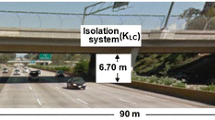Abstract
The objective of this research is to determine the effect earthquakes have on the performance of transportation network systems. To do this, bridge fragility curves, expressed as a function of peak ground acceleration (PGA) and peak ground velocity (PGV), were developed. Network damage was evaluated under the 1994 Northridge earthquake and scenario earthquakes. A probabilistic model was developed to determine the effect of repair of bridge damage on the improvement of the network performance as days passed after the event. As an example, the system performance degradation measured in terms of an index, “Drivers Delay,” is calculated for the Los Angeles area transportation system, and losses due to Drivers Delay with and without retrofit were estimated.
Similar content being viewed by others
References
ArcGIS 8.2 (1999) ESRI Inc., http://www.esri.com.
Chang SE, Shinozuka M and Moore J (2000), “Probabilistic Earthquake Scenarios: Extending Risk Analysis Methodologies to Spatially Distributed Systems,” Earthquake Spectra, 16(3): 557–572.
Eguchi RT, Goltz JD, Seligson HA, Flores PJ, Blais NC, Heaton TH and Bortugno E (1997), “Real-time Loss Estimation as an Emergency Response Decision Support System: the Early Post-Earthquake Response Tool (EPEDAT),” Earthquake Spectra, 13: 815–832.
Goltz JD (1994), “The Northridge, California Earthquake of January 17, 1994: General Reconnaissance Report,” Technical Report NCEER-94-0005, National Center for Earthquake Engineering Research, University at Buffalo, State University of New York, Buffalo, New York.
Intl. Conference of Building Officials (1994), Uniform Building Code.
National Institute of Building Sciences (1999), Earthquake Loss Estimation Methodology: HAZUS 99 (SR2) Technical Manual, Developed by Federal Emergency Management Agency, Washington DC, http://www.fema.gov/hazus.
Shinozuka M, Shiraki N and Kameda H (2000), “Performance of Highway Network Systems under Earthquake Damage,” Proceedings of the Second International Workshop on Mitigation of Seismic Effects on Transportation Structures, Taiwan, Sep. 13–15, 2000, pp. 303–317.
Shinozuka M, Kim SH, Kushiyama S and Yi JH (2002), “Fragility Curves of Concrete Bridges Retrofitted by Column Jacketing,” Journal of Earthquake Engineering and Engineering Vibration, 1(2): 195–206.
Shinozuka M, Feng MQ, Kim H, Uzawa T and Ueda T (2003), “Statistical Analysis of Bridge Fragility Curves,” Technical Report MCEER-03-0002, Multidisciplinary Center for Earthquake Engineering Research, University at Buffalo, State University of New York, Buffalo, New York.
Shiraki N (2000), “Performance of Highway Network Systems under Seismically Induced Traffic Delays,” M. S. Thesis, Kyoto University, Kyoto, Japan.
Southern California Association of Governments (1993), 1991 Origin-destination survey, Los Angeles, CA.
TriNet ShakeMap (2001), http://www.trinet.org/shake/. US Bureau of Public Roads (1964), Traffic Assignment Manual.
Author information
Authors and Affiliations
Corresponding author
Additional information
Supported by: The Federal Highway Administration (FHWA) under Contract No. DTFH61-98-C-00094 and the California Department of Transportation (CALTRANS).
Rights and permissions
About this article
Cite this article
Shinozuka, M., Murachi, Y., Dong, X. et al. Effect of seismic retrofit of bridges on transportation networks. Earthq. Engin. Engin. Vib. 2, 169–179 (2003). https://doi.org/10.1007/s11803-003-0001-0
Received:
Accepted:
Issue Date:
DOI: https://doi.org/10.1007/s11803-003-0001-0




